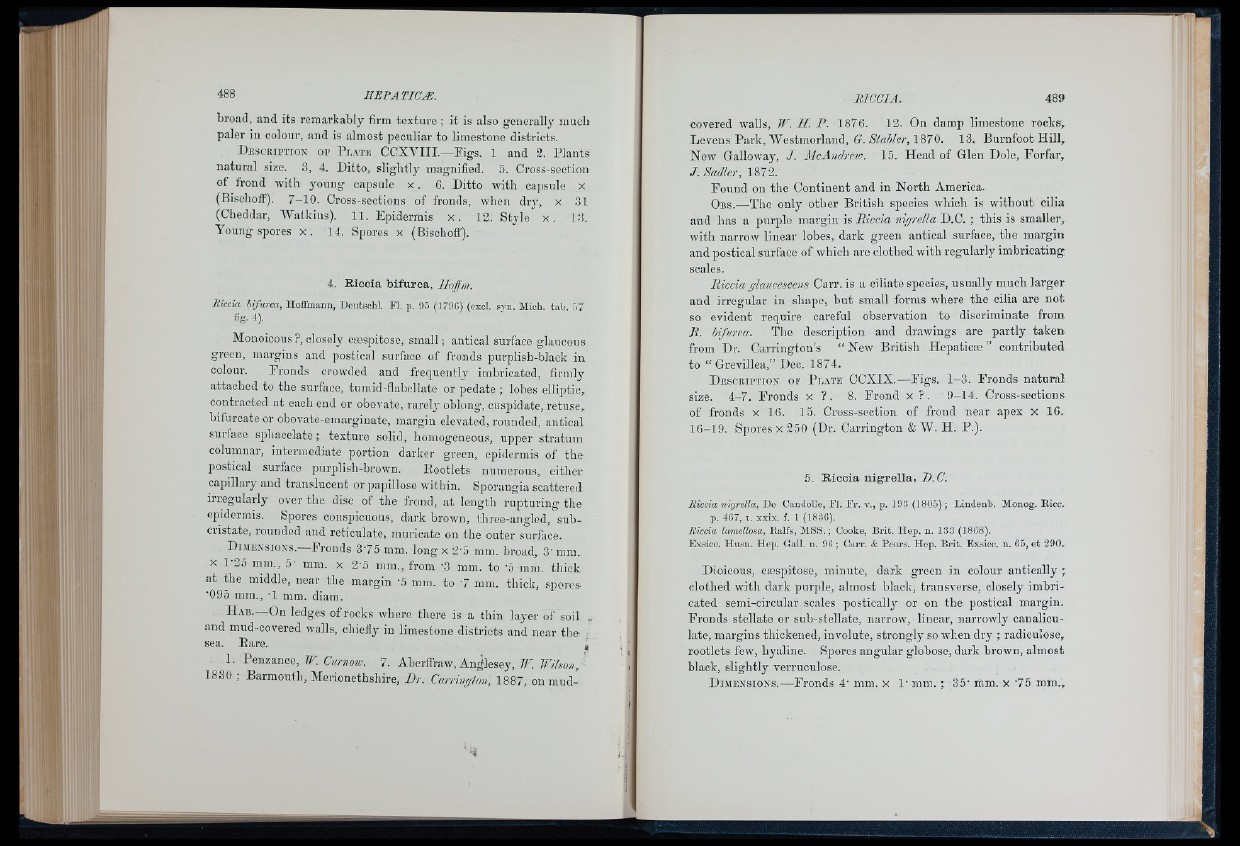
broad, and its remarkably firm texture ; it is also generally mucli
paler in colour, and is almost peculiar to limestone districts.
. Description oe P late CCXVIIL—Figs. 1 and 2. Plants,
natural size. 3, 4. Ditto, slightly magnified. 5. Cross-section
of frond with j'oung capsule x . 6. Ditto with capsule x
(Bischoff). 7-10. Cross-sections of fronds, when dry, x 31
(Cheddar, Watkins). 11. Epidermis x . 12. Style x . 13.
Young spores x . 14. Spores x (Bischoff).
4. Riccia bifurca, Hoffm.
Riccia bifurca, Hoffmann, Deutschl. F). p. 95 (179G) (excl. syn. Mich. tab. 57
fig. 4).
Monoicous ?, closely cæspitose, small ; antical surface glaucous
green, margins and postical surface of fronds purplish-black in
colour. Pronds crowded and frequently imbricated, firmly
attached to the surface, tuniid-flabellate or pedate ; lobes elliptic,
contracted at each end or obovate, rarelj' oblong, cuspidate, retuse,
bifurcate or obovate-emarginate, margin elevated, rounded, antical
surlace sphacelate ; texture solid, homogeneous, upper stratum
columnar, intermediate portion darker green, epidermis of the
postical surface purplish-brown. Rootlets numerous, either
capillary and translucent or papillose within. Sporangia scattered
irregularly over the disc of the frond, at length rupturing the
epidermis. Spores conspicuous, dark brown, three-angled, sub-
cristate. rounded and reticulate, muricate on the outer surface.
D imensions.—Fronds 375 mm. long x 2-5 ram. broad. 3 'mm.
X 1-25 mm., 5- mm. x 2'5 mm., from '3 mm. to A mm. thick
at the middle, near the margin A mm. to 7 mm. thick, spores
•095 mm., -1 mra. diam.
H ab.—On ledges of rocks where there is a thin layer of soil ,
and mud-covered walls, chiefly in limestone districts and near the
sea. Rare. ,
1. Penzance, IF. Curnow. 7. Aberffraw, Anglesey, JF. V/ihonj
1830 ; Barmouth, Merionethshire, Hr. Carriugfon, 1887, on mudcovered
walls, IF. II. P. 1876. 12. On damp limestone rocks,
Levens Park, Westmorland, G. Stabler, 1879. 13. Burnfoot Hill,
New Galloway, J. McAndrew. 15. Head of Glen Dole, Forfar,
J. Sadler, 1872.
Found on the Continent and in North America.
O b s .—The only other British species which is without cilia
and has a purple margin is Riccia nigrella D.C. ; this is smaller,
with narrow linear lobes, dark green antioal surface, the margin
and postical surfiice of whicli are clothed with regularly imbricating
scales.
Riccia glaucescens Carr, is a ciliate species, usually much larger
and irregular in shape, but small forms where the cilia are not
so evident require careful observation to discriminate from
R. bifurca. The description and drawings are partly taken
from Dr. Carrington’s “ New British Hepaticæ ” contributed
to “ Grevillea,” Deo. 1874.
D escription oe P late CCXIX.—Figs. 1-3. Fronds natural
size. 4-7. Fronds x ?. 8. Frond x ?. 9-14. Cross-sections
of fronds x 16. 15. Cross-section of frond near apex x 16.
16-19. Spores x 250 (Dr. Carrington & W. H. P.).
5. Riccia nigrella, D.C.
Riccia nigrella, De Canclolle, FI. F r. v., p. 193 (1805); Lindenb. Monog. Eicc.
p. 467, I. xxix. f, 1 (1830).
Riccia lamellosa, Ralfs, MSS. ; Cooke, Brit. Hep. n. 183 (1868).
Exsicc. Husn. Hep. Gall. n. 96 ; Carr. & Pears. Hep. Brit. Exsicc. n. 65, e t 290,
Dioicous, cæspitose, minute, dark green in colour antically ;
clothed with dark purple, almost black, transverse, closely imbricated
semi-circular scales postically or on the postical margin.
Fronds stellate or sub-stellate, narrow, linear, narrowly canaliculate,
margins thickened, involute, strongly so when dry ; radiculose,
rootlets few, hyaline. Spores angular globose, dark brown, almost
black, slightly verruculose.
D imensions.—Fronds 4- mm. x 1’ mm. ; 35’ mm. x '75 mm..